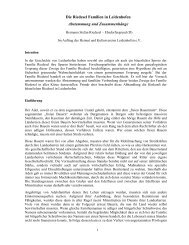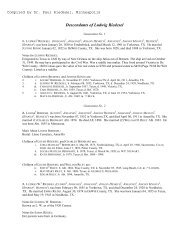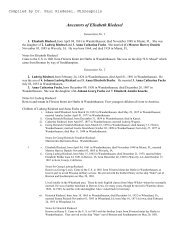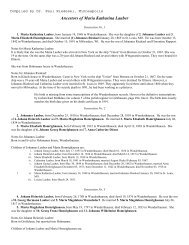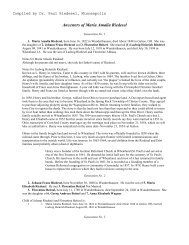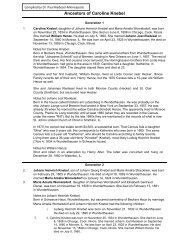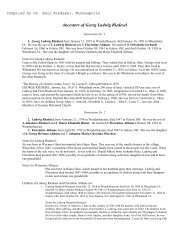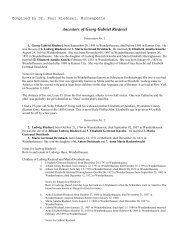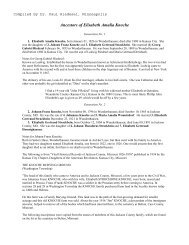Wheatland as the New Wunderthausen - Riedesel.org
Wheatland as the New Wunderthausen - Riedesel.org
Wheatland as the New Wunderthausen - Riedesel.org
You also want an ePaper? Increase the reach of your titles
YUMPU automatically turns print PDFs into web optimized ePapers that Google loves.
fields are scattered in all directions. In summer months, cattle had to be led to p<strong>as</strong>ture daily, and<br />
that land w<strong>as</strong> often an hour or two away from <strong>the</strong> village. Its population during <strong>the</strong> period of<br />
emigration w<strong>as</strong> around 450-500.<br />
Church in <strong>Wunderthausen</strong><br />
A church h<strong>as</strong> stood in <strong>Wunderthausen</strong> for centuries.<br />
The Counts converted to <strong>the</strong> Reformed/Calvinist<br />
doctrine in <strong>the</strong> 1500s, and that h<strong>as</strong> remained <strong>the</strong><br />
dominant faith. The current church w<strong>as</strong> constructed<br />
in 1957 though in <strong>the</strong> traditional style. The first<br />
dedicated school building w<strong>as</strong> erected in 1862; it<br />
w<strong>as</strong> replaced in 1895. The latter w<strong>as</strong> torn down and<br />
replaced by a modern building on ano<strong>the</strong>r site in<br />
1964. A model of <strong>the</strong> 1895 school w<strong>as</strong> built in time<br />
for <strong>Wunderthausen</strong>'s 700 year celebration in 2003.<br />
The slightly smaller village of Diedenshausen lies only a couple of kilometers south and e<strong>as</strong>t<br />
from <strong>Wunderthausen</strong>. A certain degree of rivalry h<strong>as</strong> always existed, but <strong>the</strong>ir histories have<br />
much in common. Intermarriage w<strong>as</strong> not unusual, and since <strong>the</strong> 1890s <strong>the</strong>y have formed a single<br />
parish. The larger village of Girkhausen is north and west of <strong>Wunderthausen</strong>, and could only be<br />
reached by a path through <strong>the</strong> forest known <strong>as</strong> <strong>the</strong> Kirchweg. For centuries <strong>the</strong> priest, <strong>the</strong>n p<strong>as</strong>tor,<br />
in Girkhausen w<strong>as</strong> also responsible for <strong>the</strong> two o<strong>the</strong>r villages. The faithful trudged <strong>the</strong> Kirchweg<br />
to attend Sunday services, <strong>as</strong> did <strong>the</strong> youth in preparation for <strong>the</strong>ir confirmation.<br />
It w<strong>as</strong> only around 1680 that <strong>the</strong> churches in Wittgenstein began to keep registers of births and<br />
baptisms, with records for deaths and burials beginning in 1740. Prior to those dates, <strong>the</strong>re are no<br />
solid genealogical records for <strong>the</strong> pe<strong>as</strong>ants. Earlier tax records have been used to infer lines of<br />
descent. The records for <strong>the</strong> people of <strong>Wunderthausen</strong>, Diedenshausen, and Girkhausen were all<br />
kept in <strong>the</strong> ancient church in <strong>the</strong> latter village. By agreement among <strong>the</strong> princes, <strong>the</strong> sovereign of<br />
a territory had <strong>the</strong> right to determine its religious practices. The Sayn-Wittgensteins chose <strong>the</strong><br />
Reformed (Calvinist) doctrine, and maintained close control over <strong>the</strong> p<strong>as</strong>tors, churches, and<br />
schools. 7<br />
Each village had its unique traits, history and even dialect, but in <strong>the</strong> big picture <strong>the</strong>re w<strong>as</strong><br />
nothing distinctive about <strong>Wunderthausen</strong> or any compelling re<strong>as</strong>on why it would become <strong>the</strong><br />
source of so much immigration to <strong>the</strong> southwest corner of Clinton County. As w<strong>as</strong> typically <strong>the</strong><br />
c<strong>as</strong>e, a chain of migration followed those early settlers who just happened to buy land around<br />
<strong>Wheatland</strong>.<br />
7 In <strong>the</strong> early 1700s, <strong>the</strong> Counts did in fact tolerate a small group of Pietists. Those led by Alexander Mack became<br />
what we now know <strong>as</strong> <strong>the</strong> Church of <strong>the</strong> Brethren after <strong>the</strong> toleration subsided and <strong>the</strong>y were forced to leave. Small<br />
populations of Roma (Gypsies) and Jews also lived in Wittgenstein under <strong>the</strong> sufferance of <strong>the</strong> Counts. Most were<br />
deported and killed during World War II.<br />
5



